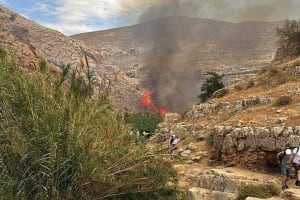How ANZAC forces helped shape Jerusalem's fate, paved way for Israel’s independence

Friday April 25, was “ANZAC Day,” without which it is unlikely there would be an Independence Day to celebrate in Israel the following week.
During the First World War, the Australian and New Zealand Army Corps (ANZAC) helped fight alongside Britain against the Turks, who were allied with the German Empire, Austria-Hungary and Bulgaria in what was known as the Quadruple Alliance, in the battle that ultimately led to Jerusalem.
They later fought with the Brits again in the Second World War against the Nazis, playing a crucial part in the future existence of the Jewish state.
It was on April 25, 1915, that Australian and New Zealand troops first arrived in the Middle East, together with British troops at Gallipoli, Turkey. The ensuing eight-month campaign led to over 56,000 allied deaths, including over 8,700 from Australia and 2,720 from New Zealand, according to Australian government statistics.
They fought valiantly, but were not able to overcome the Turks in Gallipoli. However, that was just the beginning of their heroic battles. ANZAC soldiers fought battles not only in Turkey, but also in Egypt, and what is now Israel.
On Oct. 31, 1917, the 4th Australian Light Horse Brigade famously charged and conquered the Ottoman forces who had fortified the city of Beersheva, changing history forever. It was the last such charge on horseback, and against all odds, they prevailed, opening the way to Jerusalem and to the overthrow of the Ottoman Empire that had ruled for 400 years.
The British, who had troops stationed in Egypt, had tried twice to attack the Turks at Gaza and so open the way into Israel. After two failed attempts, a new general was appointed – General Allenby.
He decided to trick the Turks into thinking that another attack was coming from the west. After being in the desert with no water for more than two days, the men and their horses were getting desperate. Their only chance was to reach the wells at Beersheva, which scouts had identified as having an unlimited water supply, but they managed to convince the Turks that they had decided an attack on Beersheva was impossible. And it almost was.
After receiving orders from Allenby, Australian General Chauvel ordered that Beersheva must be taken before nightfall if the wells were to be secured. Their daring battle plan was to charge on their unarmed horses over five kilometers of land, straight at the Turkish troops and their cannons.
Despite their exhausted state, the so-called light regiments – carrying no equipment, unlike the heavy cavalry – ran so swiftly that, with just half an hour before sunset, they quickly moved out of cannon range and leapt over the Turkish front-line trenches, where they engaged in hand-to-hand combat until the Turks were forced to retreat.
Beersheva, with its wells was not only a key turning point from a military point of view, but also biblically, being one of the first places held by Abraham in the land of Israel (Genesis 21). In one of his first acts as commander, General Allenby had issued a Bible to all his soldiers, and understood the weight of the moment when he entered Jerusalem, dismounting and removing his helmet as he passed through the Jaffa Gate.
Years later, during WWII, the British and ANZAC troops fought together again, but this time against the Nazis and their allies. Many ANZAC soldiers lost their lives in the Battle of El Alamein in northern Egypt, where the Australian and New Zealand divisions of the British army fought against German forces and thwarted the German ambition to capture Mandatory Palestine.
While ANZAC troops fought with their allies in the physical, Christian intercessors like Rees Howells and others were called to serious prayer to fight in the spiritual realm throughout the war, praying earnestly for specific battles and outcomes.
"The war had spread to North Africa and the Holy Spirit made it clear to Rees Howells that Palestine itself, the Holy Land, was in danger, threatened by a pincer movement from two directions,” wrote Doris Ruscoe in her reminiscences of the intercessory efforts of Rees Howells during the War Years of 1939-45. The battle in Egypt would prove to be another pivotal battle for the future of Israel, a future for which the ANZACs fought and ultimately secured.
Germany's field marshal for the Nazis, Erwin Rommel, wrote a letter in 1941, ironically dated on ANZAC day, April 25, describing Australian soldiers as “immensely big and powerful men, who without question represented an elite formation of the British Empire, a fact that was also evident in battle.”
Ruscoe reflected, “If Rommel took Cairo and then the German forces swept south through Russia, the fate of the Holy Land would be sealed and there would be no prospect of a national home for the Jewish people when the war was over.”
She continued, “When the war came to a head in North Africa, and the vital battle of El Alamein was taking place, we were on our knees all day and it was in the afternoon meeting that the Lord assured us of victory," wrote Roscoe. That victory came.
Following the second battle of El Alamein, Rommel said, "If I had to take hell, I would use the Australians to take it and the New Zealanders to hold it."
Along with marking ANZAC day on April 25 each year, today, there is a permanent ANZAC memorial center in Beersheva to honor their courage and sacrifice for the Land of Israel.

Jo Elizabeth has a great interest in politics and cultural developments, studying Social Policy for her first degree and gaining a Masters in Jewish Philosophy from Haifa University, but she loves to write about the Bible and its primary subject, the God of Israel. As a writer, Jo spends her time between the UK and Jerusalem, Israel.














